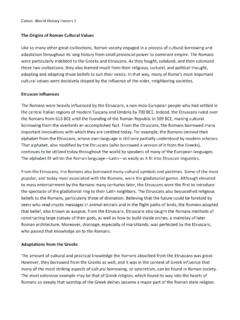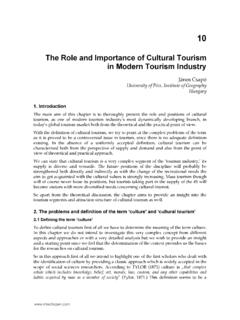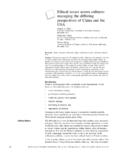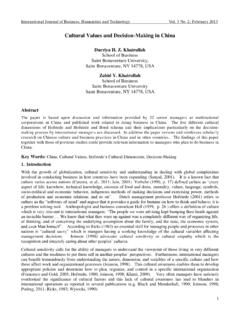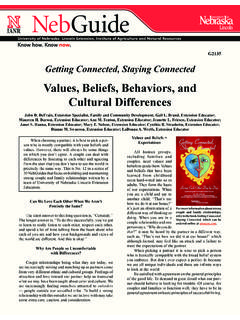Transcription of Exploring the Effects of Cultural Values and Beliefs on ...
1 10-2 Exploring the Effects of Cultural Values and Beliefs on cross - Cultural training Baiyin Yang and Yingchun Wang University of Minnesota Anne Wang Drewry Wal-Mart Corporation This article seeks to develop a framework for assessing the impacts of Cultural Values and Beliefs on cross - Cultural training (CCT). It argues that culture affects CCT processes including the use of training methods, trainers selection, and trainees learning style. The article also reasons that the congruence between parent and host cultures tends to have influences on trainees attitudes and motivation regarding the training and host culture.
2 Implications for CCT are discussed. Keywords: cross - Cultural training , Culture, Learning Style cross - Cultural training (CCT) has become an increasingly important human resource development activity due to the surge of globalization (DeSimone, Werner & Harris, 2002). The need for cross - Cultural capabilities has become crucial to conduct international business. Organizations are challenged to compete in global market. Often, corporations have to provide appropriate cross - Cultural training for expatriates and their families for foreign assignments.
3 The concept of cross - Cultural training has been evolved in several stages (Bhawuk & Brislin, 2000). While the literature on cross - Cultural training has been evolving steadily, the field tends to lack of sophisticated conceptual frameworks that can be used to adequately explain this unique training activity and guide the practice. Many scholars suggested that major empirical studies and field practices do not have a clear theoretical foundation (Adler, 1983; Black & Mendenhall, 1990; Brislin, 1981).
4 In addition, most of the existing conceptual frameworks and models of cross - Cultural training do not incorporate Cultural factors. For example, Black and Mendenhall (1990) developed a model of CCT based on Bandura s (1977) social learning theory. However, no Cultural factor has been considered in this model. Like many other models of cross - Cultural training , this model treats individual performance and adjustment as dependent variables. The core of this model consists of a linear sequential learning process starting from cross - Cultural training , to attention, retention, reproduction and skill development.
5 Selmer, Torbi n and de Leon (1998) proposed a sequential cross - Cultural training model, which suggests that trainees applicability of new behavior in host culture gradually increases in relation to the clarity of operant frame of reference. CCT involves at least two different cultures, parent and host cultures, and the Cultural differences surely will have impacts on the CCT process and outcomes. Despite their potential influences on CCT process and outcomes, culture and Cultural difference have not been featured prominently in the literature.
6 In order to overcome the deficiency of sophisticated theories of cross - Cultural training , this paper identifies major Cultural factors that influence the CCT activities. The purpose of this paper is to develop a conceptual framework of cross - Cultural training and to suggest several propositions for future research. The premise of this paper is established on a view that CCT is a learning process in which learners (or trainees) adapt to a new Framework of Culture and cross - Cultural training Because cross - Cultural training involves at least two cultures (parent and host cultures), it is inevitable to define culture and examine its impact on cross - Cultural training .
7 We first define culture and identify its major dimensions in relation to individual learning across cultures. We then develop a conceptual framework of cross - Cultural training including the Effects of Cultural factors. Culture as Collectively Shared Social Knowledge We view learning is not only an individual intellectual activity but also a social process. Most individual learning activities take place in certain social and Cultural contexts. We follow the conventional view that regards culture with two layers manifest and latent culture (Sathe, 1985).
8 Manifest culture refers to all of those visible artifacts and behaviors identified from a group of people. Latent culture is the invisible cumulative deposit of knowledge, experience, Beliefs , Values , attitudes, and meanings acquired by a group of people. In the field of management and organizational studies, it is more interesting to study latent culture and its impacts in individual Copyright 2006 Baiyin Yang, Yingchun Wang & Anne Wang Drewry21010-2behavior.
9 Therefore, culture is viewed as a system of knowledge shared by a relatively large group of people. We define culture as collectively shared social knowledge and understanding that reflected in Values , Beliefs and habitual social norms within a group of individuals. Here culture is regarded as a complex system with three interrelated sub-systems: Values , Beliefs and social norms. The above view suggests that culture can be viewed as social knowledge shared by a group of people and manifested as a group or social level of learning.
10 Cultural change involves learning of technical, social, and political dimensions of a group of individuals. Trainees learning process in CCT is a special learning activity and it tends to be influenced by immediate Cultural factors such as shared Beliefs and assumptions, acquiescent social norms, and dominant Values . Dimensions of Cultural Values and Beliefs Triandis (1995) suggested that there are potentially many definitions of culture and that each of which is valid in its own terms. One of the major contributions to cross - Cultural study has been made by Hofstede (1980, 1991).











